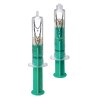- Joined
- Jul 10, 2012
- Messages
- 1,495
- Reaction score
- 1,012
Hey all. Just started doing procedures at a surgery center that is new to me. The LOR syringes they have are the ones pictured below on the left. Different than both the plastic and glass syringes I have used before. I typically like to use loss to saline but I have not been able to draw saline into these. Anyone use these? Am I missing something

Attachments
Last edited:





